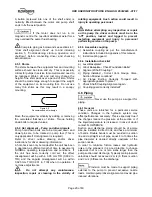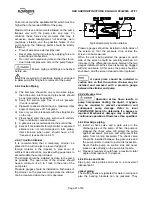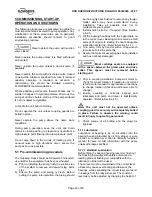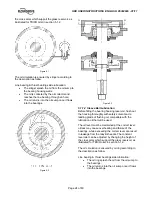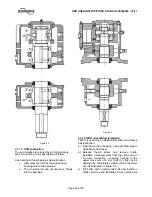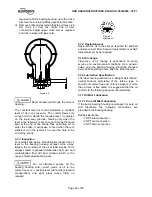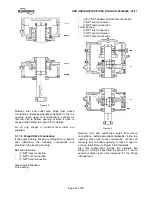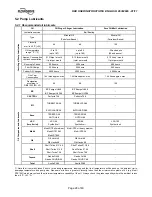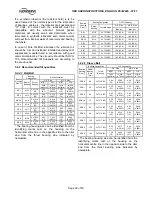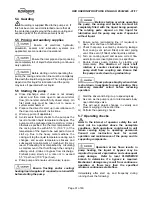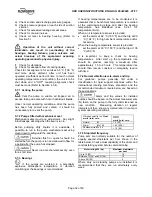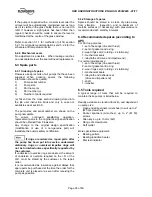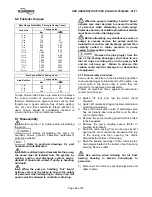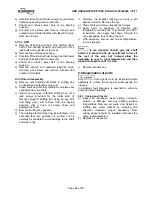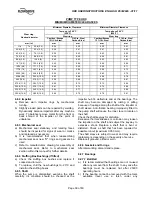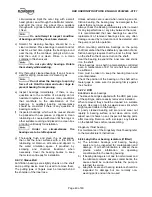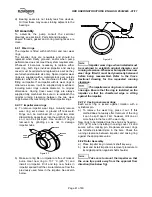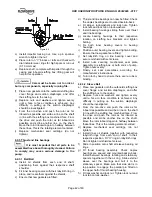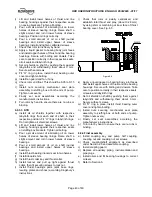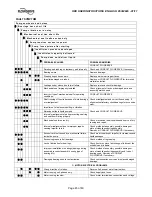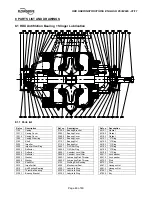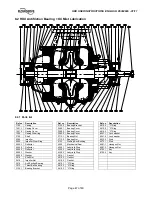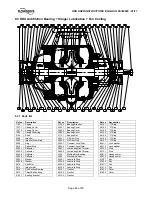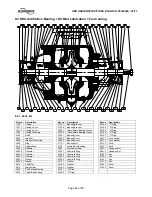
HDX USER INSTRUCTIONS ENGLISH 85392696 - 01/11
Page 34 of 60
Never clean equipment with inflammable solvents or
carbon tetrachloride. Protect yourself against toxic
fumes when using cleaning agents.
6.2 Maintenance schedule
It is recommended that a maintenance plan and
schedule is adopted, in line with these User
Instructions, to include the following:
a) Any auxiliary systems installed must be
monitored, if necessary, to ensure they function
correctly.
b) Check for any leaks from gaskets and seals. The
correct functioning of the shaft seal must be
checked regularly.
c) Check bearing lubricant level, and if the hours
run show a lubricant change is required.
d) Check that the duty condition is in the safe
operating range for the pump.
e) Check vibration, noise level and surface
temperature at the bearings to confirm
satisfactory operation.
f) Check dirt and dust is removed from areas
around close clearances, bearing housings and
motors.
g) Check coupling alignment and re-align if
necessary.
FLOWSERVE specialist service personnel can help
with preventative maintenance records and provide
condition monitoring for temperature and vibration to
identify the onset of potential problems.
If any problems are found the following sequence of
actions should take place:
a) Refer to section 7,
Faults; causes and remedies
,
for fault diagnosis.
b)
Ensure equipment complies with the
recommendations in this manual.
c) Contact Flowserve if the problem persists.
6.2.1 Routine inspection (daily/weekly)
The following checks should be made
and the appropriate action taken to remedy any
deviations:
a) Check suction and discharge gauges.
b) Check for abnormal operating conditions
(High/Low Temperature, Flows, Vibration,
Pressures Etc.)
c) Check motor current/driver power.
d) Check that there are no abnormal fluids or
lubricant leaks (static and dynamic seals) and
that any sealant systems (if fitted) are full and
operating normally.
e) Check that shaft seal leaks are within acceptable
limits.
f) Check all lubricant levels i.e. bearing housing
oilers, seal Plan 52/53, seal supply systems as
applicable.
g) On grease lubricated pumps, check running
hours since last recharge of grease or complete
grease change.
h) Check any auxiliary supplies eg heating/cooling
(if fitted) are functioning correctly.
i) Check stand by pump is at applicable
temperature and available to start as required.
Refer to the manuals of any associated
equipment for routine checks needed.
6.2.2 Periodic inspection (monthly)
a) Check for lubricant contamination whether
bearing oil, or seal oil (if applicable) by sample
analysis.
b) Check all paint or protective coatings.
c) Check all power/instrument cable glands for
tightness.
Refer to the manuals of any associated
equipment for periodic checks needed.
6.2.3 Periodic inspection (six monthly)
a)
Check foundation bolts for
security of attachment, corrosion. Check grouting
for looseness, cracking or general distress.
b) Change
lubricants.
c) Check calibration of instruments.
d) The coupling should be checked for correct
alignment and worn driving elements.
Refer to the manuals of any associated
equipment for periodic checks needed.
6.2.4 Inspection (after 3 years)
a) Check internal condition of pump and all ancillary
pipework for corrosion/erosion.
b) Check internal pump components for wear.
c) Change
bearings
6.2.5 Re-lubrication
Lubricant and bearing temperature analysis can be
useful in optimizing lubricant change intervals. In
general however, the following is recommended.
6.2.5.1 Oil lubrication
Maintaining the correct oil level is very
important.

